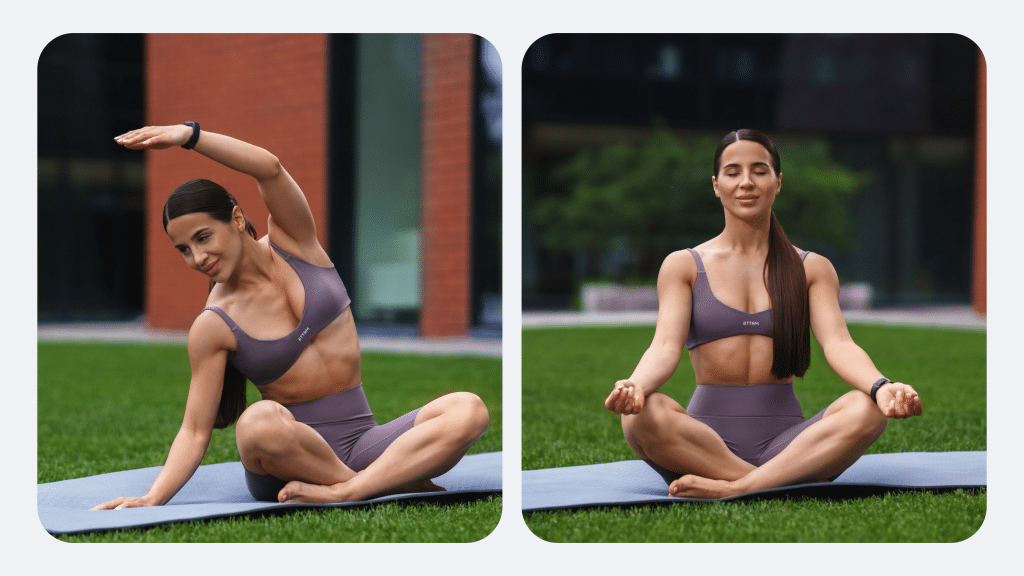Effective workouts require more than just showing up; they demand focus, precision, and the right techniques to get results. One game-changing technique is mind-muscle connection.
The mind-muscle connection is exactly what it sounds like. It’s the ability to consciously engage a specific muscle group during exercise, ensuring it works as hard as it should. This isn’t just some feel-good fitness trend; it’s rooted in how your brain communicates with your muscles through neural signals.
When done right, this practice can enhance muscle activation, improve workout focus, and help you unlock better results over time.
If you’ve never explored this concept before, don’t worry. By the end of this guide, you’ll not only understand what the mind-muscle connection is, but you’ll also have practical strategies to train smarter and gain more from each rep.
What Is the Mind-Muscle Connection?
The mind-muscle connection is the deliberate effort to focus your mind on engaging a specific muscle or group of muscles while exercising (1).
At its core, it’s about using your brain to direct your body during each move. Instead of lifting weights or performing a motion passively, you’re consciously channeling your attention to ensure the targeted muscle is doing the majority of the work.
How Does the Mind Muscle Connection Work?
To understand this better, we need to take a quick look at how muscles and the brain communicate. Your brain sends signals to your muscles through neural signals (2). These signals are like messages traveling along your nervous system’s “wiring,” telling your muscles when and how strongly to contract during a movement (3).
The messengers involved in this process are chemicals called neurotransmitters (2). Neurotransmitters carry these signals from your nerves to the muscle fibers, ensuring the muscles respond to the brain’s commands.
Now, here’s where it gets interesting. While your body can perform many movements on autopilot, not every movement is as efficient as it could be.
Sometimes, muscles that shouldn’t be heavily involved in a particular exercise can take over during a lift. This happens when you’re not intentionally engaging the right muscle group to drive the motion.
For example, when doing bicep curls, you might find your shoulders or forearms doing some of the work. That’s where the mind-muscle connection comes in—to bring your focus back to the target muscle and maximize its engagement.
This connection is also tied to motor control (4). Motor control describes your brain’s ability to coordinate and adjust muscle activity during movement.
Improved motor control means better technique, more precise movements, and less wasted energy during a workout. By dialing into the mind-muscle connection, you’re boosting this coordination.
BetterMe: Health Coaching app helps you achieve your body goals with ease and efficiency by helping to choose proper meal plans and effective workouts. Start using our app and you will see good results in a short time.
Why is the Mind Muscle Connection Critical for Your Fitness Goals?
Why is any of this important? Because the more you can actively engage the muscles you’re working, the more effective your workout becomes (5). Enhanced engagement can lead to better muscle growth, improved strength, and reduced risk of injury caused by incorrect movement patterns (6).
Think of it like a phone call with your muscles. A strong mind-muscle connection ensures that the signal gets through loud and clear, so the right muscles pick up on the message and do their job. Without it, the signal is weaker, and your body might resort to compensating with other muscles, which could lead to inefficient exercises or strain in areas that shouldn’t be working as hard.
The good news is that anyone can train this connection. It just takes practice and the right approach to really tap into it—but once you do, it can completely change how effective and enjoyable your workouts feel.
Read more: Bend, Stretch, And Flow With Yoga Routines That Improve Flexibility
What Are the Benefits of Enhancing Your Mind Muscle Connection?
By understanding and enhancing the mind-muscle connection, you create a foundation for more effective and injury-free training.
- Improved Muscle Activation
When you strengthen your mind-muscle connection, you can engage the target muscles with greater precision (5).
This is particularly useful when performing compound exercises, which work multiple muscle groups at the same time. By focusing on the primary muscle you want to train, you ensure it bears the majority of the workload.
This heightened activation helps you train the muscle more effectively and minimizes involvement from unwanted areas. Over time, this precise engagement supports stronger and more efficient muscle contractions.
- Better Workout Efficiency
Enhancing the mind-muscle connection ensures that every rep you perform counts. Instead of just going through the motions, you direct your effort to specific muscles, making each movement intentional (4). This focus helps reduce wasted energy on compensatory muscle usage, where other muscles try to do the work that the target muscle should handle.
- Reduced Risk of Injury
When other muscles step in to compensate for poor muscle engagement, it can strain areas that aren’t meant to handle the load.
For example, during a bench press, if your chest isn’t properly engaged, your shoulders or triceps might take on more than they should. This compensation can lead to overuse, imbalances, and eventually injury.
By practicing the mind-muscle connection, you improve your ability to recruit the correct muscles while maintaining proper body alignment, protecting your joints and tendons in the long term (4).
- Enhanced Muscle Growth
Hypertrophy, or muscle growth, happens when muscle fibers are sufficiently stressed during resistance training. If you’re unable to engage a muscle deeply during an exercise, you aren’t maximizing this stress, which may limit your ability to see physical changes over time.
The mind-muscle connection places targeted tension directly on the desired muscle. This focused activation not only optimizes muscle growth but also allows you to achieve a more symmetrical and balanced physique by evenly developing underperforming muscles (5).
- Improved Body Awareness and Control
Developing your mind-muscle connection enhances proprioception (7, 8), which is your body’s sense of position and movement in space. This increased body awareness makes your form more controlled and deliberate during exercises.
You’ll feel more confident in complex movements, like deadlifts or squats, because you can better coordinate your muscles.
Over time, this enhanced control translates into better posture, balance, and overall movement patterns, which are beneficial both inside and outside the gym.
Does Mind-Muscle Connection Boost Your Motivation?
One key factor is the enhanced focus required to intentionally engage specific muscles during exercise. This level of mental involvement can make your workouts feel more purposeful and structured, which some people find deeply satisfying.
When you direct your attention to the muscle you’re working, you often experience immediate feedback. You feel the target muscle contract and burn, confirming that your effort is hitting the right spot. This real-time validation can build a sense of accomplishment, reinforcing a positive relationship with your workouts.
There’s also an element of mindfulness involved in this practice. Being present in the moment and connecting with your body can reduce distractions and create a more immersive workout experience. Over time, this level of engagement may help sustain consistency and enjoyment, which are critical for long-term fitness goals.
However, individual responses to this technique can vary. While some may find it motivational, others might not experience the same psychological lift. The benefits largely depend on how you approach your training and whether the added focus aligns with your personal fitness mindset.
What Are Some Practical Techniques to Strengthen Your Mind-Muscle Connection?
By implementing these proven techniques, you can train smarter, improve your control of muscle movements, and get more out of every workout.
1. Practice Visualization Techniques
Visualization is a mental strategy for fitness that helps you connect with the muscle you’re working. By imagining the muscle contracting before and during an exercise, you enhance the brain-to-muscle connection. Here’s how to apply it:
- Step 1: Before your workout, picture the exercise you’re about to do. Visualize the target muscle activating and performing the movement.
- Step 2: During the exercise, keep your mental focus on the sensation in the muscle. Imagine it shortening (contracting) and lengthening with each rep.
- Step 3: Avoid distractions and stay present. The clearer the image in your mind, the stronger your ability to engage in targeting specific muscles.
Visualization creates a mental “rehearsal” that helps improve muscle engagement during the actual movement.
2. Use Isolation Exercises for Muscle Focus
Isolation exercises target a single muscle group, making them ideal for strengthening the mind-muscle connection (5). Movements like bicep curls or leg extensions minimize the role of secondary muscles, helping you focus entirely on the primary muscle. Steps to maximize their effect include:
- Step 1: Choose exercises designed for the specific muscle you want to target. For example, perform tricep kickbacks to isolate your triceps.
- Step 2: Use lighter weights initially. This helps you control muscle movements and concentrate on form without relying on momentum.
- Step 3: Focus on the contraction. For instance, during a bicep curl, feel the muscle tighten as you lift and stretch as you lower the weight.
- Step 4: Slow down your tempo. Moving deliberately increases workout precision and helps you better connect with the motion.
Isolation exercises make it easier to “listen” to your muscles and refine your focus on form and control.
3. Slow Down Your Movements
Slowing down your reps forces you to engage target muscles more deliberately. It also enhances workout precision techniques by eliminating momentum. Steps to implement this approach include:
- Step 1: Reduce the speed of your reps. Count to three during the lifting phase and another three when lowering the weight.
- Step 2: Pay close attention to the muscle being worked. You should feel tension throughout the entire range of motion.
- Step 3: If the exercise feels too easy, adjust the resistance until you can feel the muscle work without straining other areas. But also be sure to not go too heavy to the point where you are losing this mind muscle connection. Sometimes going with a lighter weight allows you to feel the exercise more.
This method encourages controlled muscle movements and builds stronger neural pathways between your brain and muscles.
4. Touch the Target Muscle
Using physical touch is a simple but effective way to improve brain-to-muscle connection. Lightly placing your hand on the working muscle during an exercise helps you physically feel it contract. Steps to apply this technique:
- Step 1: Choose an exercise where you can comfortably reach the target muscle, like side lateral raises for your shoulders.
- Step 2: Before you begin, touch the muscle you want to engage. This helps bring your focus to that specific area.
- Step 3: Perform the motion while keeping your hand lightly on the muscle. Feel it contract and relax with each repetition.
This hands-on method reinforces your mind-muscle techniques by combining physical sensation with mental awareness.
Reasons why BetterMe is a safe bet: a wide range of calorie-blasting workouts, finger-licking recipes, 24/7 support, challenges that’ll keep you on your best game, and that just scratches the surface! Start using our app and watch the magic happen.
5. Focus on Form and Control
Proper form is the foundation of effective strength training and helps you engage the correct muscles (9). To improve mind-muscle connection for strength training, follow these steps:
- Step 1: Watch yourself in a mirror, if possible. This helps ensure your alignment and posture stay correct.
- Step 2: Start with a moderate weight. Using excessive weight can compromise your form and shift the work to unintended muscles.
- Step 3: Tighten the targeted muscle before starting the movement. For example, brace your core during a plank to engage the abdominal muscles right from the start.
- Step 4: Avoid rushing through exercises. Perform each movement with deliberate control, pausing briefly at the top and bottom of the motion.
By focusing on form, you’ll train more effectively and reduce reliance on secondary muscles.
6. Incorporate Pauses and Squeezes
Adding pauses or squeezes at the peak of a movement forces you to concentrate on the muscle you’re engaging. Here’s how to do it:
- Step 1: At the top of each rep, hold the position for 1-3 seconds.
- Step 2: Actively squeeze the muscle during this pause. For example, when squatting, pause at the bottom and squeeze your glutes before standing back up.
- Step 3: Resume the movement slowly to maintain tension.
Pauses increase time under tension, a key factor in building stronger neural activation in fitness and improving muscle activation.
7. Incorporate Mental Strategies for Fitness
Lastly, practices like mindfulness or breathing techniques can support your ability to stay focused. When you’re mentally present, you can better direct your effort to specific muscles. How to include this:
- Step 1: Before your workout, take a few deep breaths to calm and center yourself.
- Step 2: During exercise, stay mindful of your breathing, inhaling as you lower the weight and exhaling as you lift.
- Step 3: If distractions occur, reset your focus by thinking about the muscle and its movement.
Mental focus sharpens the mind-muscle connection and ensures you engage the right muscles at the right time.
Read more: Yoga For Weight Loss: The Beginner’s Guide
Myth-Busting the Mind-Muscle Connection
- Myth: It’s Only for Bodybuilders
While bodybuilders often champion the mind-muscle connection, it’s not exclusive to them. This technique is valuable for anyone who trains, from beginners to advanced athletes. It helps improve muscle engagement during exercises, no matter your goal.
For instance, focusing on this connection can enhance strength training, aid rehabilitation, or correct muscle imbalances. Even functional fitness routines can benefit from better brain-to-muscle coordination. The truth is, this tool isn’t limited to sculpting biceps or chiseling abs; it’s about training smarter for all fitness levels.
- Myth: It Doesn’t Work for Cardio
Although the mind-muscle connection is often associated with strength training, it can benefit cardio too. When running or cycling, concentrating on specific muscles, like your quads or glutes, can improve efficiency and reduce fatigue. It will also work to reduce your likelihood of injury. If every step you take on a stair stepper is with proper form, then you are much less likely to injure yourself on longer cardio sessions.
Another example, activating your glutes during a run helps you generate more power and maintain proper form. Even in activities like swimming or rowing, engaging target muscles boosts performance. Cardio isn’t just about endurance; precision can play a major role too.
- Myth: You Can’t Train It
Many people believe you either have the mind-muscle connection or you don’t, but that’s not true. This skill is trainable, much like strength or flexibility. Techniques like visualization, slowing down movements, and focusing on form all help strengthen the connection.
It may take time and consistent effort, but anyone can develop better control over how their muscles behave during exercise. Repetition creates stronger neural pathways, making it easier to engage specific muscles over time (8).
- Myth: It’s Just About Thinking Harder
A common misconception is that the mind-muscle connection is simply about concentrating harder. While mental focus plays a role, there’s more to it.
The connection involves neural signals traveling from the brain to the muscles, facilitated by motor control pathways and neurotransmitters. These signals tell your muscles when and how to contract (2).
The process is physical and neurological, not just mental. Think of it as training your body and your brain to communicate more effectively, rather than willing it to happen through sheer effort.
- Myth: It’s Not Backed by Science
Some dismiss the mind-muscle connection as a fitness fad, but research supports its effectiveness.
Studies show that focusing on a target muscle increases its activation during exercises (1). For example, concentrating on your glutes during a hip thrust leads to greater engagement in that area compared to not focusing at all.
Evidence also suggests that over time, refining this connection can contribute to better strength, coordination, and muscle growth (5). It’s a well-documented feature of proper training, not a baseless theory.
The mind-muscle connection is your brain’s ability to focus on and building muscle control during exercise. It improves muscle engagement by strengthening the neural signals that activate the target muscle (4). This leads to better form, enhanced efficiency, and more precise workouts. It’s important because it helps you train smarter, reduce the risk of injury, and maximize results over time. Beginners can improve by starting with simple techniques. Focus on isolation exercises that target one muscle group at a time. Slow down movements to feel the contraction and release of the muscle. Visualization also helps; picture the muscle working before and during the exercise. Consistency is key. With practice, muscle control will improve. It works for both. While often associated with strength training, the mind-muscle connection can enhance cardio too. Focusing on specific muscles, like engaging your glutes during running or your quads during cycling, can improve efficiency and power. It supports proper form and reduces unnecessary strain, making cardio workouts more effective. Isolation exercises are the most effective. Movements like bicep curls, tricep extensions, and leg extensions are great examples. Compound exercises can also help, but they require more focus on form. Slowing down reps, using lighter weights, and adding pauses or squeezes at the peak of a motion are excellent ways to strengthen the connection. It depends on the individual and their consistency. Some may notice better muscle engagement within a few weeks, while others may take longer. Regular practice, focused attention, and proper technique are essential for progress. Over time, neural pathways strengthen, making the connection feel more natural and automatic.Frequently Asked Questions
What is the mind-muscle connection, and why is it important?
How can beginners improve their mind-muscle connection?
Does the mind-muscle connection work for cardio or just strength training?
What are the best exercises to develop the mind-muscle connection?
How long does it take to strengthen the mind-muscle connection?
The Bottom Line
The mind-muscle connection is a valuable technique that bridges the gap between your brain and body. By focusing on the specific muscles you’re working, you can improve muscle engagement, enhance workout precision, and achieve more effective results in both strength training and cardio. Practical techniques, like visualization, slowing down movements, and isolation exercises, provide accessible ways to develop this skill over time.
DISCLAIMER:
This article is intended for general informational purposes only and does not serve to address individual circumstances. It is not a substitute for professional advice or help and should not be relied on for making any kind of decision-making. Any action taken as a direct or indirect result of the information in this article is entirely at your own risk and is your sole responsibility.
BetterMe, its content staff, and its medical advisors accept no responsibility for inaccuracies, errors, misstatements, inconsistencies, or omissions and specifically disclaim any liability, loss or risk, personal, professional or otherwise, which may be incurred as a consequence, directly or indirectly, of the use and/or application of any content.
You should always seek the advice of your physician or other qualified health provider with any questions you may have regarding a medical condition or your specific situation. Never disregard professional medical advice or delay seeking it because of BetterMe content. If you suspect or think you may have a medical emergency, call your doctor.
SOURCES:
- The mind–muscle connection in resistance training: friend or foe? (2016, springer.com)
- Neurons: How the Brain Communicates (2024, mhanational.org)
- Brain Connectivity Associated with Muscle Synergies in Humans (2015, pmc.ncbi.nlm.nih.gov)
- New insights on mind-muscle connection: motor imagery concomitant to actual resistance training enhances force performance (2025, jsams.org)
- Importance of mind-muscle connection during progressive resistance training (2015, springer.com)
- Effects of functional correction training on movement patterns and physical fitness in male college students (2024, pmc.ncbi.nlm.nih.gov)
- The neurobiological effects of mind–body exercise: a systematic review and meta-analysis of neuroimaging studies (2023, nature.com)
- The Effectiveness of Proprioceptive Training for Improving Motor Performance and Motor Dysfunction: A Systematic Review (2022, frontiersin.org)
- ~Benefits of Proper Form and Technique during~Resistance Training~ (n.d., walkitscience.org)










